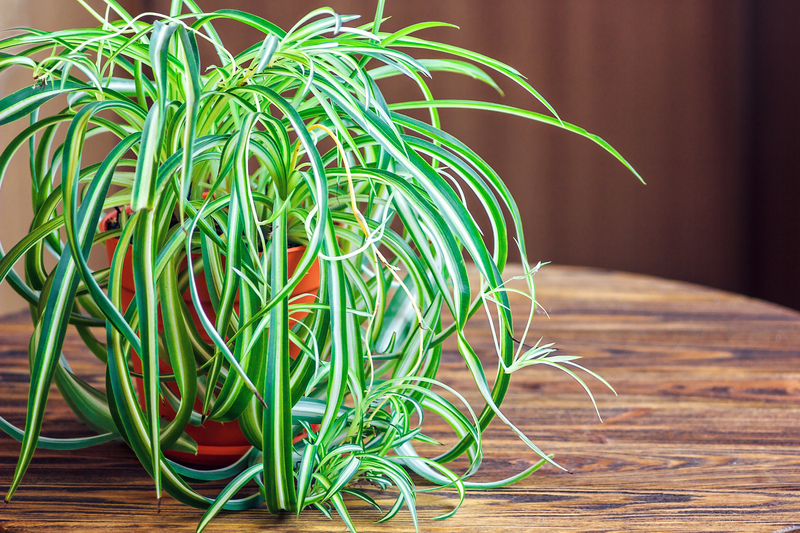Explore Inspiring Zen Gardens for Restful Outdoor Spaces
Posted on 22/09/2025
Explore Inspiring Zen Gardens for Restful Outdoor Spaces
Looking for a way to transform your backyard or patio into a haven of tranquility? Zen gardens for restful outdoor spaces have captivated homeowners and designers worldwide for their minimalist beauty and calming ambiance. Whether you have a sprawling lawn or a tiny balcony, incorporating elements of a Zen-inspired garden can help you foster relaxation, mindfulness, and a deeper connection with nature right at home.
What is a Zen Garden?
Zen gardens, also known as Japanese rock gardens or Karesansui, originated in Japan over six centuries ago. Traditionally designed for Buddhist monks as places for meditation, these gardens reflect the principles of simplicity, harmony, and natural beauty. Instead of relying on flowering plants, modern Zen gardens focus on rocks, gravel, sand, and carefully chosen greenery to evoke peaceful landscapes and balance.
- Minimalist design: Emphasis on space and simplicity helps eliminate distractions.
- Symbolic elements: Stones, raked sand or gravel, and sparse plants symbolize mountains, rivers, or islands.
- Mindfulness in design: Each element is placed deliberately, encouraging calm reflection and mindfulness.

Benefits of Zen Gardens for Outdoor Relaxation
Introducing a Zen garden into your outdoor space offers numerous wellness and aesthetic benefits:
- Stress Relief: The clean lines, gentle flow, and organized patterns encourage peaceful contemplation, reducing everyday stress.
- Low Maintenance: Unlike traditional gardens, Zen gardens require minimal upkeep--no mowing or pruning intensive flower beds.
- Improved Focus and Mindfulness: Raking patterns in sand and maintaining order can serve as a meditative practice.
- Versatility: These gardens work in any size yard, courtyard, or even on a balcony, making the restful ambiance accessible to everyone.
- Natural Beauty Year-Round: The evergreen elements and non-floral focus mean Zen gardens look serene in every season.
Essential Elements of Inspiring Zen Gardens
To create restful outdoor spaces inspired by traditional Zen gardens, it's important to understand the fundamental elements that make these gardens unique. The synergy of these components crafts an environment that feels both robust and tranquil.
1. Rocks and Stones
In inspiring Zen gardens, rocks symbolize natural features like mountains, islands, or animals. Choose stones with natural shapes and arrange them in odd numbers or asymmetrical groups for a more organic feel.
- Larger stones often serve as focal points or represent mountains.
- Smaller stones or pebbles can create pathways or borders.
2. Sand and Gravel
Sand or gravel in a Zen outdoor restful space represents water or waves. Carefully raking these materials into ripples or swirling patterns fosters a sense of movement and mindfulness. White or light gray crushed granite or pea gravel is most popular.
3. Plants and Greenery
While plants take a backseat in Zen gardens, the right selection adds subtle color and texture:
- Moss, ferns, and small evergreens: Provide a touch of green year-round.
- Bamboo: Symbol of strength and flexibility, bamboo creates privacy and harmony.
- Maple or cherry trees: Add seasonal interest with delicate leaves or blooms.
4. Water Features
Though not always present, water or the suggestion of water (with gravel streams or pools) enhances the tranquil vibe. A small koi pond, reflecting pool, or even a simple bamboo fountain can elevate a Zen-inspired backyard.
5. Pathways and Bridges
Curved stone, stepping stones, or sand paths guide movement and symbolize the journey of life. Bridges, even small ones, can connect different sections and add visual interest.
6. Decorative Touches
Simple lanterns, stone basins, and rustic benches blend function with understated beauty. Each accessory should be purposeful, encouraging restful contemplation.
Design Principles for Restful Outdoor Zen Spaces
Embracing the philosophy behind Zen gardens is as important as choosing the right elements. Here are core design principles to follow:
- Simplicity (Kanso): Remove non-essential items. Let negative space contribute to the overall feel.
- Naturalness (Shizen): Use natural shapes and materials, avoiding symmetry and artificial finishes.
- Subtlety (Yugen): Suggest beauty and depth with understatement, not extravagance.
- Balance and Asymmetry: Arrange rocks, plants, and features so that the space feels balanced even when it's not perfectly symmetrical.
- Enclosure: Use fencing, plants, or rocks to create an intimate, protected environment.
- Symbolism: Allow elements to carry personal or natural symbolism, such as using a specific number of stones, or arranging them to mirror a mountain pass.
Step-By-Step Guide: Creating a Zen Garden in Your Backyard
1. Plan Your Space
- Sketch a layout, even for a small patio or balcony.
- Mark areas for rocks, sand, paths, and greenery.
2. Prepare the Ground
- Clear debris and weeds.
- Lay landscape fabric to prevent unwanted growth.
- Add a border (wood, stone, or metal) to define the garden's perimeter.
3. Place Stones
- Select stones with distinct shapes and sizes.
- Position them according to your sketched plan; odd-numbered groupings feel more natural.
4. Add Gravel or Sand
- Spread gravel or sand evenly across the designated area.
- Use a rake to create soothing ripple or wave patterns.
5. Incorporate Greenery
- Plant moss, ferns, or dwarf shrubs around stones.
- Consider a small bamboo cluster or a Japanese maple for height.
6. Introduce Water Elements
- Add a mini pond, stream, or bamboo water spout for sensory appeal.
- For a minimalist touch, simply shape your gravel to suggest a stream's flow.
7. Add Finishing Touches
- Install a stone lantern for gentle light in the evening.
- Include a wooden or stone bench for seating and contemplation.
- Arrange all features mindfully for an inviting, restful space.
Inspirational Zen Garden Ideas for Every Outdoor Space
Explore these creative ways to adapt Zen-inspired gardens to any size or type of outdoor environment:
Urban Balcony Retreat
- Fill a low planter with sand or gravel.
- Add a few artfully chosen rocks and a bonsai for greenery.
- Place a small stone lantern for ambiance.
- Enjoy a personal slice of serenity right outside your apartment.
Backyard Meditation Garden
- Create a secluded area with bamboo fencing or tall shrubs.
- Install a winding path of stepping stones leading to a meditation seat.
- Include a tranquil water feature, such as a small pond or bubbling fountain.
- Surround with soothing moss and dwarf conifers for year-round greenery.
Front Yard Welcome Zen Garden
- Frame your walkway with raked gravel beds and strategically placed boulders.
- Highlight the entryway with a stone basin (tsukubai) and bamboo ladle.
- Keep plantings minimal for a clean, inviting aesthetic.
Mini Zen Garden for Tabletop or Desk
- Use a shallow tray, fine sand, and tiny stones to craft a desktop Zen retreat.
- Rake new patterns throughout the day to relieve stress and focus the mind.
- Add a figurine or small candle for a touch of inspiration.
Maintenance Tips to Keep Your Zen Garden Restful
While Zen gardens for restful outdoor spaces are known for their low maintenance, a little regular care will ensure they stay beautiful and inviting:
- Remove debris: Clear away fallen leaves, twigs, or any clutter promptly.
- Rake regularly: Refresh sand or gravel patterns to restore their soothing lines.
- Prune sparingly: Shape greenery to maintain the intended minimalist effect.
- Check water features: Keep water clean and ensure pumps or fountains function smoothly.
- Weed control: Address any unwanted growth immediately to preserve the clean look.

Frequently Asked Questions About Zen Gardens
Can I create a Zen garden in a small outdoor area?
Absolutely! Zen gardens are ideal for compact spaces. Even a container garden or a balcony corner can become a peaceful oasis with a bit of gravel, a few artistic rocks, and a small patch of greenery.
Do Zen gardens always need sand or gravel?
While sand or gravel is traditional, especially for dry landscape gardens, you can adapt the concept. Use small pebbles, mulch, or even raked soil for a similar effect in your restful outdoor space.
How do I personalize my Zen garden?
Incorporate objects that have special meaning (such as a unique stone found during travels) or select plants and features that resonate with you. The best inspiring Zen gardens reflect the personalities and needs of their creators.
What materials are best for a low-maintenance Zen garden?
Gravel or pebbles, sturdy rocks, moss, and drought-tolerant plants make for a resilient, easy-care landscape. Choose weather-resistant touches like stone lanterns or ceramic basins for lasting beauty.
Conclusion: Embrace Tranquility with a Zen Garden
In today's fast-paced world, cultivating a Zen-inspired garden for restful outdoor spaces is one of the most effective ways to invite peace, order, and happiness into your life. Whether you're seeking a private meditation retreat or a visually appealing, low-maintenance yard, these gardens deliver benefits for the mind and senses alike.
Ready to design your own inspiring Zen garden? Start with thoughtful simplicity, embrace natural materials, and let your space be a sanctuary for reflection and renewal. Allow your outdoor area to become a true embodiment of Zen--calm, harmonious, and infinitely restful.

